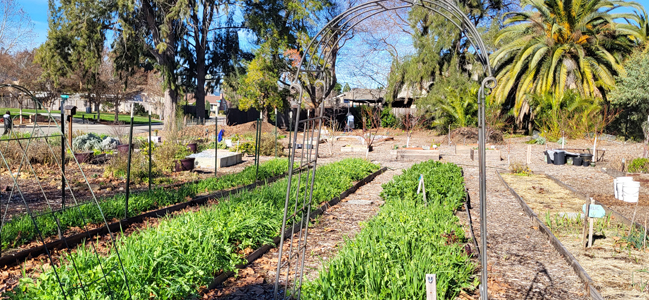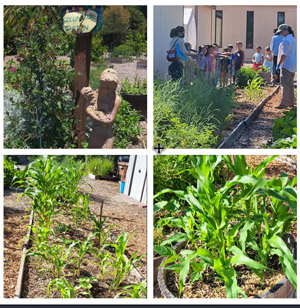Clare's Fare Garden

For up-to-date information about what is going on at Clare's garden, see Clare's Garden.
Participation
This service project is open to garden club members and community members. All volunteers are welcome, no experience is necessary. Volunteers decide how often they will come and for how long they will stay. The group appreciates all volunteer participation.
Meeting times
Typically, Clare's Garden has harvest and work days on Wednesdays and Saturdays. The frequency and days might change depending on the time of year. See the LAVGC Calendar, LAVGC Newsletter or Clare's Garden for meeting dates each month.
For more information and to be added to the group's mailing list, send email to the leaders on Contact Us.
Directions
Clare's Fare Garden is located on the side of St Clare's Episcopal Church, 3350 Hopyard Road, Pleasanton, CA 94588. Access to the garden is from National Park Road, off North or South Valley Trails Road, which intersects Hopyard Road.
Garden design and history
Initially four long in-ground beds for vegetables were created in an undeveloped section of church property. Ten additional beds have been added for with one for collard greens, several for herbs, and the rest for vegetables.
A pollinator garden curves around the veggie beds. Two other wildflower and plant beds have been developed to attract bees, birds, and pollinators. There is also an orchard of 18 trees. Nasturtiums were planted beneath the apple trees to deter codling moth and also to supply Culinary Angels with edible flowers. Native wildflowers have been planted scattered around the garden. A barn owl nest box was installed in the garden to keep rodents at bay.
Three compost bins base on This Old House design were built and are kept filled with browns, greens, air and water to produce compost which helps build healthy, productive soil.
Unique to this garden is a Hügelkultur bed, which is generating heat (83 degrees F) as the woody materials start to decompose. This special bed is an area that is producing very nice vegetable crops including sweet potatoes, garlic, onions and squash.
Hügelkultur (German for hill/mound cultivation) is an old technique that involves planting on top of buried decaying material such as tree trunks and branches. There are many instructional videos available online. The benefits of hügelkultur are said to include:
- Water retention;(the wood acts as a sponge, holding and releasing moisture, so good for dryland agriculture and the water shortages we are likely to face)
- Provides slow release of nutrients
- Warms the root zone via decomposition
- Returns carbon to the soil
- Good way to solve a wood disposal problem
- Cheaper-than-dirt way to fill a raised bed or depression
- Self tilling because it settles over time.
Pictures
In September we plant the "3 sisters", corn, beans and squash.
 Read more about our work in September.
Read more about our work in September.
See more Clare's Fare Garden pictures from 2020-2021 including the Hügelkultur bed.